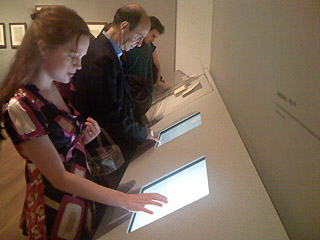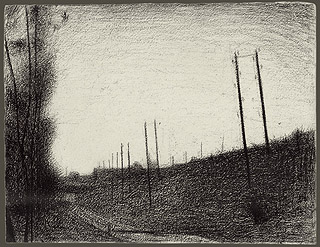It’s hard to understate the pride I felt on behalf of my colleagues at Behavior when I read these words in Friday’s New York Times:

The Museum of Modern Art’s elegantly plain exhibition of Georges Seurat’s drawings begins with an unexpectedly extraordinary moment of computerized art viewing. Seurat’s four surviving notebooks have been converted to electronic versions that — with a touch of a finger — visitors can flip through, page by digital page, from cover to dog-eared cover. (The real notebooks can also be seen under glass nearby.)
Facsimiles they may be, but they instantly communicate the show’s intent, which is to clarify the way the silent, classical remove of Seurat’s impeccable, stylized paintings was distilled from an active, socially aware engagement with the world that registered most fully in his drawings.
If you haven’t guessed already, the touch-screen interfaces in question were designed and built by my studio mates at Behavior, both as kiosk installations in the MoMA exhibition gallery and viewable on the web as a gorgeous online exhibition.
Roberta Smith of the Times is one of the the most important art critics around. So when the opening sentence of Smith’s review of Georges Seurat: The Drawings focuses so enthusiastically on the interactive kiosk that my colleagues put together these past few months, it’s more than just praise for Georges Seurat and for the great curation and leadership by the team at MoMA. It’s also praise for Behavior.
Touch Screens in the Age of the iPhone
Most of the Behavior folks attended the exhibition’s lavish opening festivities last week, and we all got a chance to watch dozens of very fancy people interacting with the twin touch-screen kiosks. It was such a joy to watch the gallery-goers flip through the pages with looks of, I swear, genuine delight on their faces. No lie: I definitely heard “ooohs” and “aaahs”.

As with any usability test situation, of course, there were also the occasional moments where a user would try to do something we didn’t think of. Of particular interest was the fairly common attempt by users to treat the traditional touch screens as if they were iPhone-style multi-touch screens. People expected to be able to smoothly zoom in by spreading two fingers apart as they can on the iPhone. As with so much of what Apple does, the bar has apparently been raised in unexpected new places in the interactive landscape.
What About the Art?

Oh, and the show is absolutely luminous. I hope you check out the web site, of course, but if you enjoy art at all you must see the show in person. The sketchbooks are just a tiny piece of the exhibit. The rest of the show, and the online exhibition, includes drawings and paintings, historical conservation information, and of course the sketchbooks.
The exhibition is getting rave reviews from many other sources as well, and deservedly so. We’ve all seen Seurat’s famous pointillist paintings, especially the revolutionary A Sunday Afternoon on the Island of La Grande Jatte. But Seurat’s drawings reveal the intense thinking and talent that went into his painterly work.
The drawings excel in two areas simultaneously: Form and light. In a vivid metaphorical image conjured up by my wife Peggy (seen above), some drawings suggest that 19th century Paris would be transparent or even invisible if not for the industrial-era soot filling the air and collecting on any and all solid objects and forms. The charcoal on the page reflects the density of the matter in the space.
And yet other drawings emphasize light itself, with the space articulated only by where the light exists and where it does not — where traditional drawing marks like contour lines are banished. The relationship between this thinking and the daguerrotype photography of the time is hard to dispute.
The best works attack form and light at the same time, and it’s easy to see how Seurat’s eschewing of contour and lines — and embrace of volume and light — leads directly to La Grande Jatte, even without the extraordinary discoveries in color he is most famous for.
La Grande Jatte was painted when Seurat was just 26. He would die five years later, at 31. It’s staggering to imagine what he would have gone on to accomplish had he lived into the age of Matisse (born the same year as Seurat), Kandinsky, and Picasso.
Comments
4 responses to “Georges Seurat Dot Com”
You had the multitouch style ‘press and flick’? I find that really cool. Much better than just tapping on a screen.
I think this is a great example of how great UI design transcends the product itself – look how the play/ff/rew/stop icons have been so transformative for media playback, for example. Now every media player/dvd player/radio/bathtub has them.
Apple didn’t just bring to market a phone – they brought how we should be using touchscreen devices to the general public. If this means I can be using pinch and flick gestures on displays then I am all for it.
@Ben: Unfortunately, we only had traditional single-touch screens (it is, after all, a UI that needs to work on the web as well). But you’re absolutely right that the iPhone’s popularity has created a state of conceptual ubiquity for multi-touch — a paradigm that a year ago only existed in Jeff Han’s astonishing demo video. I wonder how long it will be until ATMs have multitouch displays?
That’s a shame… however multitouch is still only in it’s infancy. I think the iPhone made touch screens more popular in general, even if it’s a single input screen.
I saw the Jeff Han talk a while back and it really impressed me.
And no, I don’t think we’ll be seeing the technology in ATM machines just yet. I can’t see the practicality in using more than one finger on their screens, just yet… after all you just select options from a list.
Congrats on the coverage, that’s really something!
As far as multitouch goes, it’s wonderful to see touch and gesture language finally being disseminated out there. Anything that helps drive demand for more useful touch/multitouch systems — just like ATM machines (ever used their screen keyboards?) — is highly welcome in my book. And then, that means your next kiosk might get to use that technology too. 🙂